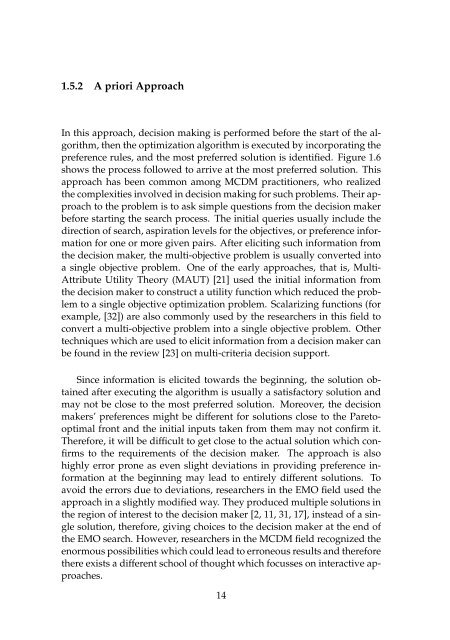Progressively Interactive Evolutionary Multi-Objective Optimization ...
Progressively Interactive Evolutionary Multi-Objective Optimization ...
Progressively Interactive Evolutionary Multi-Objective Optimization ...
Create successful ePaper yourself
Turn your PDF publications into a flip-book with our unique Google optimized e-Paper software.
1.5.2 A priori Approach<br />
In this approach, decision making is performed before the start of the algorithm,<br />
then the optimization algorithm is executed by incorporating the<br />
preference rules, and the most preferred solution is identified. Figure 1.6<br />
shows the process followed to arrive at the most preferred solution. This<br />
approach has been common among MCDM practitioners, who realized<br />
the complexities involved in decision making for such problems. Their approach<br />
to the problem is to ask simple questions from the decision maker<br />
before starting the search process. The initial queries usually include the<br />
direction of search, aspiration levels for the objectives, or preference information<br />
for one or more given pairs. After eliciting such information from<br />
the decision maker, the multi-objective problem is usually converted into<br />
a single objective problem. One of the early approaches, that is, <strong>Multi</strong>-<br />
Attribute Utility Theory (MAUT) [21] used the initial information from<br />
the decision maker to construct a utility function which reduced the problem<br />
to a single objective optimization problem. Scalarizing functions (for<br />
example, [32]) are also commonly used by the researchers in this field to<br />
convert a multi-objective problem into a single objective problem. Other<br />
techniques which are used to elicit information from a decision maker can<br />
be found in the review [23] on multi-criteria decision support.<br />
Since information is elicited towards the beginning, the solution obtained<br />
after executing the algorithm is usually a satisfactory solution and<br />
may not be close to the most preferred solution. Moreover, the decision<br />
makers’ preferences might be different for solutions close to the Paretooptimal<br />
front and the initial inputs taken from them may not confirm it.<br />
Therefore, it will be difficult to get close to the actual solution which confirms<br />
to the requirements of the decision maker. The approach is also<br />
highly error prone as even slight deviations in providing preference information<br />
at the beginning may lead to entirely different solutions. To<br />
avoid the errors due to deviations, researchers in the EMO field used the<br />
approach in a slightly modified way. They produced multiple solutions in<br />
the region of interest to the decision maker [2, 11, 31, 17], instead of a single<br />
solution, therefore, giving choices to the decision maker at the end of<br />
the EMO search. However, researchers in the MCDM field recognized the<br />
enormous possibilities which could lead to erroneous results and therefore<br />
there exists a different school of thought which focusses on interactive approaches.<br />
14
















